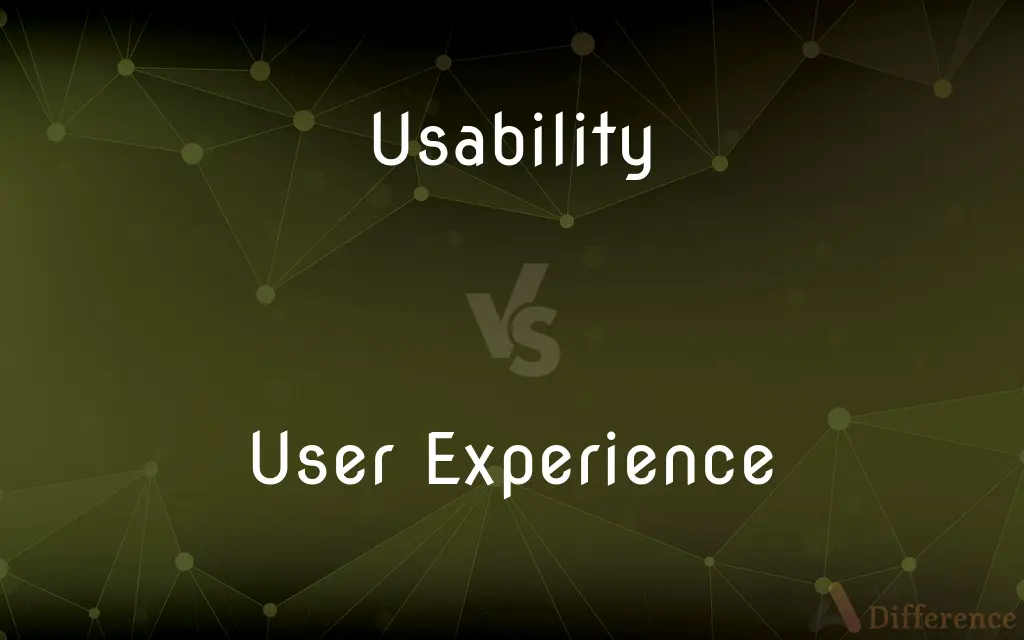Usability vs. User Experience — What's the Difference?
Edited by Tayyaba Rehman — By Fiza Rafique — Published on October 9, 2023
Usability refers to the ease of use of a product, while User Experience (UX) encompasses all aspects of a user's interaction with a product, including emotions and perceptions.

Difference Between Usability and User Experience
Table of Contents
ADVERTISEMENT
Key Differences
Usability and User Experience are both crucial elements in product design but serve different roles. Usability focuses on the practical aspects of a product, ensuring it's functional, efficient, and easy to use. User Experience, on the other hand, delves deeper, considering how the product makes a user feel, encompassing satisfaction, pleasure, and the overall journey with the product.
While Usability might concentrate on aspects such as how easily a user can complete a task or navigate a website, User Experience will assess the entire journey, from the user's initial interaction to their feelings post-use. Essentially, a product might be usable (easy to use) but might not offer a positive User Experience if it doesn’t elicit positive emotions.
In a digital context, Usability might relate to the intuitive nature of a website's menu, ensuring users can find what they need swiftly. User Experience would encompass this but would also consider the aesthetic appeal of the site, the feelings it evokes, and the memories it creates.
Comparison Chart
Focus
Ease of use of a product
Overall interaction, including emotions and perceptions
Scope
Narrower, centered on functionality
Broader, covering the entire user journey
ADVERTISEMENT
Outcome
Functional, efficient product
Positive feelings, memorable experiences
Measurement
Task completion rate, efficiency
Satisfaction ratings, emotional feedback
Goal
To make a product straightforward and user-friendly
To create a holistic, positive interaction between user and product
Compare with Definitions
Usability
The ease with which a product can be used.
The app's usability was enhanced with an intuitive interface.
User Experience
How a product meets the needs and expectations of its users.
Investing in user experience led to higher customer retention.
Usability
The simplicity and efficiency of a product's design.
The device's usability was a selling point for many consumers.
User Experience
The overall feel and response elicited by using a product.
The user experience of the website was immersive and enjoyable.
Usability
How effectively a user can interact with a product.
The website's usability metrics showed high task completion rates.
User Experience
The totality of interactions between a user and a product.
Their platform offers a seamless user experience.
Usability
The degree to which a product avoids user errors.
The system's usability reduced the likelihood of user mistakes.
User Experience
The emotions and perceptions evoked by a product.
The app's user experience was enhanced with vibrant visuals.
Usability
A measure of a product's user-friendliness.
Usability testing revealed areas for improvement.
User Experience
A user's journey from initial contact to final interaction with a product.
Feedback indicated a positive user experience throughout.
Usability
Capable of being used
Usable byproducts.
Usability
Fit for use; convenient to use
Usable spare parts.
Usability
The state or condition of being usable.
Usability
The degree to which an object, device, software application, etc. is easy to use with no specific training.
Common Curiosities
How do aesthetics play into these concepts?
Aesthetics can influence user experience significantly but might not always impact usability directly.
How are usability and user experience measured?
Usability often uses metrics like task completion, while user experience might use satisfaction ratings or emotional feedback.
What's the primary difference between usability and user experience?
Usability is about ease of use, while user experience covers the entire interaction, including emotions.
Can good user experience compensate for poor usability?
Not always. A product needs to be usable first; then, enhanced user experience can add value.
Are both usability and user experience crucial in design?
Absolutely, a product should be both usable and offer a positive user experience for success.
How do these concepts relate to mobile apps?
Both are vital. Apps need to be user-friendly (usability) and offer a positive interaction (user experience).
Can a product be usable but have a poor user experience?
Yes, a product might be easy to use but may not evoke positive feelings or meet user expectations.
Are feedback and reviews more about usability or user experience?
Both. Users might comment on ease of use (usability) or how they felt using the product (user experience).
How have these concepts evolved with technology?
With digital advancements, the emphasis on both usability and user experience has grown, especially in software and app design.
Is usability more technical than user experience?
Typically, yes. Usability often focuses on functional aspects, while user experience delves into emotions.
Are there professionals specialized in each area?
Yes, there are usability experts and user experience (UX) designers, though many professionals encompass both.
How do usability tests differ from user experience tests?
Usability tests often focus on task efficiency, while user experience tests evaluate the broader interaction.
Does user experience only relate to digital products?
No, any product or service can offer a user experience, be it digital or physical.
Are there universal standards for usability and user experience?
While there are best practices, what's usable or offers a good user experience can vary based on culture, demographics, and individual preferences.
Can one improve without affecting the other?
It's possible, but improving usability often positively influences user experience.
Share Your Discovery

Previous Comparison
Betrayal vs. Treason
Next Comparison
Lithograph vs. PrintAuthor Spotlight
Written by
Fiza RafiqueFiza Rafique is a skilled content writer at AskDifference.com, where she meticulously refines and enhances written pieces. Drawing from her vast editorial expertise, Fiza ensures clarity, accuracy, and precision in every article. Passionate about language, she continually seeks to elevate the quality of content for readers worldwide.
Edited by
Tayyaba RehmanTayyaba Rehman is a distinguished writer, currently serving as a primary contributor to askdifference.com. As a researcher in semantics and etymology, Tayyaba's passion for the complexity of languages and their distinctions has found a perfect home on the platform. Tayyaba delves into the intricacies of language, distinguishing between commonly confused words and phrases, thereby providing clarity for readers worldwide.
















































